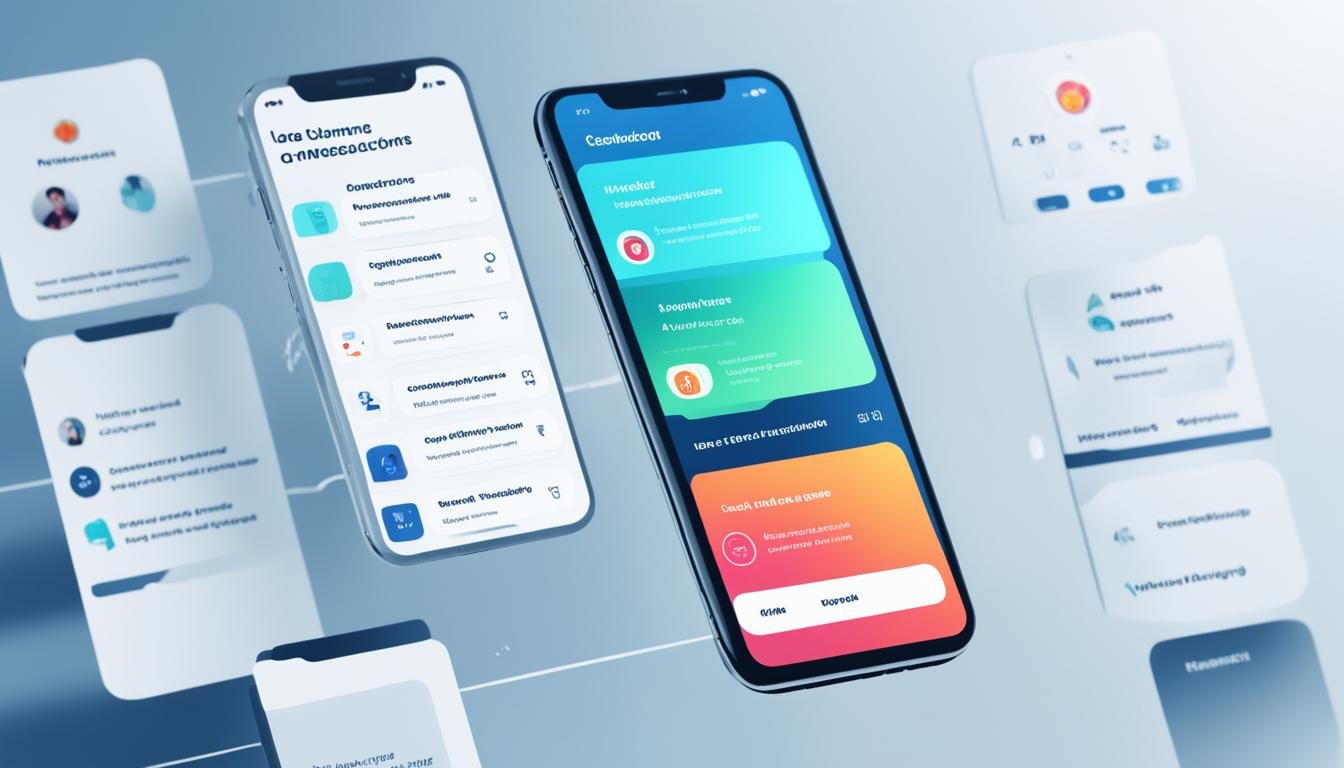Heads up – This post includes affiliate links. If you click and purchase, I may received a commission at no extra cost to you. I only recommend products which I have personally vetted.
AI app development is evolving rapidly, capturing the attention of developers and businesses. In 2024, we’ll see major shifts in AI-powered applications. Multimodal AI models and generative AI tools are leading this transformation.
These changes will reshape how we interact with technology. New trends are emerging that could revolutionize our digital experiences. Let’s explore what’s on the horizon for AI apps in 2024.
Key Takeaways
- Multimodal AI models like GPT-4 and Gemini are unlocking new possibilities for AI-powered applications, processing text, images, and videos.
- User-friendly AI model customization platforms are empowering individuals to create tailored chatbots and other AI-driven solutions without coding expertise.
- Advancements in text-to-video generation are revolutionizing the film industry, enabling new special effects, deepfake avatars, and content creation.
- The rise of AI-generated disinformation and deepfakes poses significant challenges in content verification and election integrity.
- General-purpose robots powered by multimodal AI are poised to transform a wide range of industries, from manufacturing to healthcare.
The Rise of User-Friendly AI Model Customization Tools
Tech companies are creating easy-to-use platforms for AI chatbot customization. These tools allow anyone to make AI chatbots without coding skills. This trend stems from pressure on Google and OpenAI to monetize their Conversational AI and Multimodal AI products.
These platforms will enable the creation of many tailored AI models. They unlock new possibilities for GPT-4, Gemini, and other No-Code AI applications. Users can now use AI power without needing technical expertise.
This trend is revolutionizing access to advanced AI capabilities. It empowers businesses and individuals to create unique, personalized solutions. As AI evolves, we’ll see more innovative applications in the future.
Advancements in Text-to-Video Generation
Text-to-Video AI models are revolutionizing content creation. Startups like Runway lead the charge with their Generative Video Models. These models create Pixar-quality animation from simple text prompts.
Major studios and marketing firms are embracing this technology. They’re exploring AI in Film Production throughout their pipelines. This includes seamless lip-syncing for foreign-language overdubs and creating stunning Deepfake Avatars.
The global market for Text-to-Video AI is booming. Projections show it reaching $900 million by 2027. This represents an impressive 37.1% annual growth rate.
| AI Text-to-Video App Development Costs | Range |
|---|---|
| Simple AI Text-to-Video Apps | $8,000 – $16,000 |
| Average AI Text-to-Video Apps | $16,000 – $30,000 |
| Complex AI Text-to-Video Apps | $30,000+ |
Text-to-Video AI technology is rapidly evolving. Its applications are set to expand further. This will change how we create and consume content in the future.
AI-Generated Election Disinformation and Deepfakes
AI-generated election disinformation and deepfakes pose a significant challenge for the 2024 elections. Generative AI makes it easy to create realistic fake content online. This raises concerns about voter trust and electoral integrity.
A Moody’s report highlights worries about generative AI’s impact on U.S. election integrity. Google and Facebook may capture 47% of the $306.94 billion U.S. digital ad spending in 2024. This increases the risk of AI disinformation spreading rapidly.
Meta now requires AI disclosure for all ads. They’ve also banned new political ads before elections. These steps aim to address the growing issue of AI-generated misinformation.
Governments and tech companies are working to tackle AI-generated fake news. State legislatures introduced over 50 AI-related bills weekly as of February. Eight states have enacted laws on election interference and deepfakes since January.
Experts warn that circumventing AI deepfake safeguards remains relatively easy. This could potentially disenfranchise voters and affect democracy. Robust regulations and effective strategies are crucial to protect election integrity.
| Statistic | Value |
|---|---|
| U.S. digital advertising spending in 2024 | $306.94 billion |
| Percentage of U.S. digital advertising spending captured by Google and Facebook | 47% |
| Pieces of AI-related legislation introduced weekly in state legislatures as of February | Over 50 |
| Number of states that have enacted laws on election interference and deepfakes since January | 8 |
AI-generated election disinformation is a global issue affecting over 50 countries in 2024. The European Union is taking a proactive approach to combat this threat. They’re requiring social media platforms to reduce disinformation and election manipulation.
The EU will start labeling AI deepfakes next year. This regulation aims to increase transparency and protect voters. Public awareness is crucial to maintain trust in democratic institutions.
The fight against AI-generated disinformation will test policymakers, tech companies, and citizens. Effective strategies are needed to safeguard the upcoming election cycle. The integrity of our democracy depends on our ability to tackle this challenge.
General-Purpose Robots Powered by Multimodal AI
Multimodal AI is revolutionizing robotics. Inspired by GPT-4 and Gemini, roboticists are creating general-purpose robots that can multitask. These AI-powered robots aim to perform various tasks, similar to large language models.
NVIDIA has introduced Project GR00T, a general-purpose foundation model for humanoid robots. These multimodal robotics systems understand natural language and learn from human actions. They interact with the world more smoothly than ever before.
NVIDIA is working with 1X Technologies, Agility Robotics, and Boston Dynamics. Together, they’re speeding up the development of versatile robotic platforms. This collaboration aims to push the boundaries of robotics learning.
Creating truly general-purpose robots faces challenges. The biggest hurdle is the lack of diverse training data. Roboticists are working hard to overcome this obstacle.
As multimodal robotics advances, we’ll see more capable and adaptable robots. These innovations have the potential to transform our daily lives and work environments.
AI App Development Trends
The AI research community is now focusing on smaller, more efficient models. Recent advancements in LLaMA, Llama 2, and Mistral show impressive performance with fewer parameters. This makes Efficient AI Models easier to deploy on various devices and platforms.
Multimodal AI models are gaining traction, integrating vision and language capabilities. These advanced models can process and generate content across multiple data types. They pave the way for Explainable AI applications, offering intuitive and comprehensive user experiences.
Developers and businesses are ready to use these cutting-edge technologies. They aim to create innovative, efficient, and user-friendly applications. These apps will deliver personalized experiences and intelligent insights.
Efficient AI Models and Multimodal AI are shaping the future of app development. They promise to change how we interact with digital products and services.
Model Optimization and Local AI Deployment
AI-powered apps are on the rise, but GPU shortages and cloud costs pose challenges. Luckily, AI model optimization and local deployment offer solutions. These advancements help businesses overcome hurdles in AI implementation.
Optimizing AI Models for Efficiency
Smaller, more efficient AI models like LLaMA, Llama 2, and Mistral address AI Model Optimization needs. They run on various hardware, including Edge Computing devices. This makes AI more accessible across different settings.
Developers use model pruning, quantization, and distillation to create smaller, energy-efficient AI models. These techniques maintain performance while tackling GPU Shortages and Cloud Computing Costs.
Bringing AI to the Edge
Local AI Deployment allows businesses to run AI models on edge devices. This includes smartphones, smart home hubs, and industrial equipment. Edge computing reduces cloud reliance, lowers latency, and boosts data privacy.
- Edge computing enables real-time decision-making, ideal for low-latency applications like autonomous vehicles and smart cities.
- Running AI models locally helps businesses avoid GPU Shortages and Cloud Computing Costs linked to cloud-based AI.
- Containerization technologies, like Docker, ensure smooth deployment and scalability of AI models across edge devices.
The focus on AI Model Optimization and Local AI Deployment is growing. These strategies empower businesses to use AI effectively. They also help overcome GPU shortages and rising cloud computing costs.

Rise of Powerful Virtual Agents
Multimodal Virtual Agents are changing how we interact with technology. These AI-powered assistants process text, images, and video seamlessly. They offer users a more intuitive and versatile interaction experience.
AI models like GPT-4 and Gemini are enhancing virtual assistants’ capabilities. They can now understand and respond to diverse user inputs effectively. These agents engage in natural dialogues, offering personalized solutions tailored to your needs.
Conversational AI in mobile apps provides intelligent assistance at your fingertips. Intelligent apps use machine learning and natural language processing. They’re revolutionizing tech interactions and boosting user engagement and productivity.
The future of Virtual Agents includes exciting AI applications in mobile development. We may see augmented reality integrations and advanced predictive algorithms. These agents will likely become an integral part of our digital lives.
| Key Trends in Multimodal Virtual Agents | Benefits of AI-Powered Virtual Agents |
|---|---|
|
|
AI Regulation, Copyright, and Ethical Concerns
AI technology’s rapid growth brings crucial issues to the forefront. These include regulation, copyright, and ethical use. Policymakers must address concerns like deepfakes and AI-powered election disinformation. Protecting intellectual property and ensuring responsible AI development are vital.
Maintaining accountability for these powerful technologies is essential. The future agenda will be shaped by how we handle these challenges. Balancing innovation with safety and ethics is key.
AI Regulation and Governance
The U.S. lacks federal AI regulations, but some states are creating their own. The EU leads with its AI Act, a landmark legislation for AI governance. These frameworks will address privacy, bias, and accountability concerns.
AI Regulation and AI Governance measures are gaining momentum. They’ll play a crucial role in shaping responsible AI development. Global cooperation will be essential for effective AI oversight.
Copyright and AI-Generated Content
AI Copyright challenges have led to legal disputes over AI-generated content ownership. Advanced AI generators raise questions about rightful ownership and usage. Authors have sued tech companies for unauthorized use of copyrighted works in AI training.
Navigating the complex legal landscape of AI Copyright is crucial. Policymakers and industry stakeholders must find fair solutions. Balancing innovation with creator rights will be an ongoing challenge.
Ethical Considerations of AI
Ethical AI practices are vital as AI becomes more widespread. Job displacement, bias, and potential misuse are major concerns. Deepfakes and election disinformation highlight the need for robust ethical frameworks.
The NIST AI Risk Management Framework guides responsible AI development. It ensures these technologies benefit society as a whole. Ethical considerations must be at the forefront of AI advancement.
Addressing regulation, copyright, and ethical challenges is crucial for AI’s future. These issues will shape how we harness AI’s potential. Responsible development will ensure AI benefits humanity while minimizing risks.
| Key AI Regulation and Governance Initiatives | Overview |
|---|---|
| European Union’s AI Act | A comprehensive regulatory framework aiming to ensure the safe and ethical development and use of AI systems in the EU. |
| NIST AI Risk Management Framework | A voluntary framework that provides guidance on managing AI-related risks and fostering the responsible design, development, deployment, and use of AI systems. |
| U.S. State-Level AI Regulations | Several U.S. states, such as California and New York, have begun implementing their own regulations and guidelines for the use of AI technologies. |
Shadow AI and Corporate AI Policies
Businesses are creating policies to control AI use by employees. These policies tackle “shadow AI” challenges. They ensure AI aligns with company values, security, and ethics.
Addressing the Risks of Shadow AI
Shadow AI is using artificial intelligence without approval. This can lead to data security risks and quality control issues. It may also cause operational problems and legal troubles.
Unauthorized AI tools can cause system failures and compatibility issues. They might expose organizations to lawsuits, fines, or reputation damage.
Corporate AI Policies are crucial to reduce these risks. They guide employees on proper AI tool use. This ensures Employee AI Use follows the organization’s AI Governance in Enterprises.
| Key Challenges in Managing Shadow AI | Recommended Strategies for Addressing Shadow AI |
|---|---|
|
|
Addressing Shadow AI and implementing Corporate AI Policies is crucial. This ensures AI deployment aligns with AI Governance in Enterprises. It reduces risks and unlocks AI’s full potential.

Internet of Things (IoT) App Integration
The IoT market is booming, creating new opportunities for mobile apps. These apps now work with connected devices in many industries. Smart homes, healthcare, and transportation are just a few examples.
Mobile apps are vital for controlling, monitoring, and automating IoT systems. They provide easy-to-use interfaces for users to manage their connected devices.
Unlocking the Potential of Mobile Apps and IoT
IoT app integration helps businesses improve user experiences and boost productivity. It also enables innovative services through connected devices.
Mobile apps with IoT offer many benefits. These include seamless connectivity, personalized experiences, and smart automation.
- Uninterrupted connectivity and data synchronization
- Personalized experiences through AI and machine learning
- Seamless automation and data-driven decision-making
- Expanded features and functionality for connected devices
- New revenue streams through subscription models and in-app purchases
The IoT market growth is pushing companies to invest in mobile apps and IoT solutions. This helps them meet the needs of tech-savvy users.
| IoT Sector | Potential Mobile App Integration |
|---|---|
| Smart Home | Remote device control, energy management, security monitoring |
| Healthcare | Remote patient monitoring, medication management, telehealth |
| Transportation | Fleet management, route optimization, predictive maintenance |
| Manufacturing | Asset tracking, production monitoring, predictive maintenance |
Partnering with expert IoT app developers can unlock the full potential of these solutions. It enables businesses to create innovative, user-friendly mobile experiences.
Apps for Foldable Devices
Foldable smartphones have created new opportunities for mobile app developers. These devices can switch between compact phone and larger tablet-like displays. App developers must adapt their applications to these dynamic form factors.
Mobile App Design for Foldable Screens requires understanding user experience and device capabilities. Developers must consider how apps respond to folding and unfolding. They need to ensure a consistent interface that boosts productivity and engagement.
Responsive App Development for Foldable Devices
Foldable smartphones challenge app developers to optimize for different screen sizes. Responsive App Development is crucial for smooth transitions between device configurations. Apps must adjust their layout, content, and functionality based on the form factor.
Developers can use adaptive layout, dynamic scaling, and multi-window support. These techniques ensure great user experiences on Foldable Devices. Apps should perform well whether the screen is folded or unfolded.
| Feature | Importance for Foldable Devices |
|---|---|
| Adaptive Layout | Ensures the app’s UI and content adapt seamlessly to different screen sizes and aspect ratios. |
| Dynamic Scaling | Enables the app to scale its elements and content proportionally as the screen size changes. |
| Multi-Window Support | Allows the app to function optimally in split-screen or multi-window scenarios on foldable devices. |
Smartphone Market Trends show foldable devices gaining popularity. Mobile app developers must adapt to these innovative form factors. Embracing these changes will keep developers competitive in the evolving market.
Conclusion
AI app development is changing fast. Exciting trends are shaping the industry for 2024 and beyond. User-friendly AI tools and text-to-video tech are transforming mobile app creation.
AI-generated election lies and deepfakes pose big challenges. We need strong strategies to fight them. Multimodal AI powers versatile general-purpose robots, showing the tech’s potential.
Model optimization and local AI deployment are advancing quickly. Powerful virtual agents are becoming more common and easy to use.
AI is reshaping mobile app development’s future. Businesses must navigate new rules, copyright issues, and ethical concerns. AI enhances IoT app integration and apps for foldable devices.
FAQ
What are the key AI app development trends that will shape 2024?
How are tech companies enabling anyone to create customized AI chatbots?
What is the new frontier in generative AI?
How will AI-generated election disinformation impact the 2024 elections?
How are roboticists building general-purpose robots powered by multimodal AI?
How are advancements in smaller, more efficient AI models making the technology more accessible?
How are multimodal AI models enabling the development of more intuitive virtual assistants?
How are businesses addressing the challenges and risks of AI use by employees?
How is the growth of the IoT market creating new opportunities for mobile app development?
How are foldable smartphones creating new challenges for mobile app developers?
Heads up – This post includes affiliate links. If you click and purchase, I may received a commission at no extra cost to you. I only recommend products which I have personally vetted.





Leave a Reply